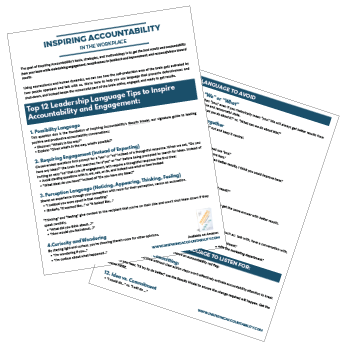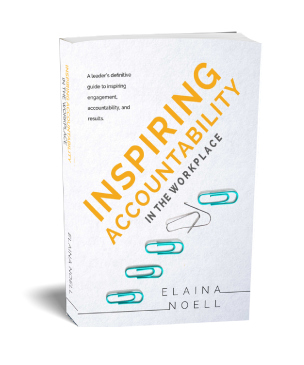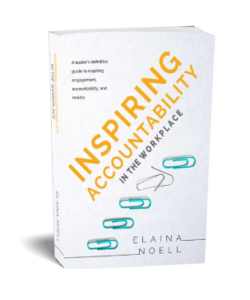
Employee Engagement Ideas
If you’re looking for employee engagement ideas, especially when so many are remote employees today, be careful of solving the problem with quick-fix after-hours events. These can mask the real engagement issues and sometimes even create more guilt and resentment than the feel-good motivation and connection you’re looking to inspire.
Instead, let’s look to improve engagement within the day-to-day work!
Let’s look at the most common areas where you might want to see improved engagement:
- Employees more engaged in their work, and
- Employees more engaged in company culture/with each other.
Let’s look at employee engagement ideas for each one of these.
Employee Engagement Ideas: Engaged in their work
Inspiring Accountability defines engagement as the percentage of effort provided and the feeling experienced during the effort.
As you’ve likely experienced, you can put effort into your work, but feel bored or anxious doing it. You can also put minimal effort into a task but feel great doing it, but this isn’t quite what we’re going for either.
We want employees to give 100% effort and feel good during the effort. This is the combination that incentivizes the brain to keep engaging.
If you want to optimize effort, here are some ideas:
Fuel an employee’s sense of contribution, competence, and importance.
These are the top three in the Hierarchy of Human Needs in the Workplace that affect employee engagement and accountability.
Contribution: Proactively outline the contribution context or why the work is important and what or whom it impacts. Any task worth doing has a why behind it, and a leader can improve employee engagement by always ensuring the employee understands why what they are doing matters.
Competence: Provide adequate recognition of met expectations. You want your employees’ brains to serve up those feel-good success indicators, so throw a neurochemical party! You want your employees to experience dopamine (“I did it”) and serotonin (“You did it!) so that these rewards become incentives.
Importance: Ensure your leadership stance maintains that each employee offers a valued and unique contribution, communicating something like, “I’m glad you’re here and in this role. We need you, and you make a difference.” Employees might technically be replaceable, but if you treat people as such, you’ll guarantee turnover. We all want to feel important, and when we believe we are seen as important, we are more likely to keep supporting that belief with aligned action.
Provide adequate and effective recognition and rewards.
Rewards become engagement incentives. Provide genuine acknowledgment to incentivize the brain to keep providing great effort, as we capture in our Employee Engagement and Experience Loop model.
Improve Accountability
Humans love accountability when delivered in a supportive way that helps them feel seen as contributing, competent, and important. Feedback is a gift from leaders when done effectively. And it’s only natural that the brain will do better work when believed inevitable.
Infuse some challenge into the mundane day-to-day
Employees’ brains get highly engaged in problem-solving and growth opportunities when paired with clarity, confidence, and optimism (in our next section). Look for opportunities to empower employees to do more problem-solving and support them in working on developmental goals.
Not that you have some areas worth your attention on driving effort, let’s look at some ideas to help employees feel good during that effort:
Employee Engagement Ideas: FEELING GOOD
Employees who feel great do great work, and employees who do great work feel great. This cycle is what we are aiming for to improve engagement.
Start by asking yourself: What would help employees feel good while providing effort? What helps you feel good while providing effort?
In addition to the effort-boosting ideas above, to feel good while doing their work, we need a sense of:
Clarity in what is expected to be successful: “I know what’s expected:” I know what’s expected of me to be 100% successful
Confidence in abilities: “I can do this” I believe I have the skills or resourcefulness to meet this expectation
Optimism about a rewarding outcome: “I am enough and will be seen as successful” I believe I can and will be successful in meeting my boss’ expectations
How can you contribute to employees having greater clarity, confidence, and optimism?
Now let’s look at the second common desired outcome of engagement.
Engaged in Culture (and with each other):
Being part of company culture is like attending a party – your conscious (or subconscious brain) tends to ask:
- Do I want to be here?
- Do I belong?
- Am I having a good time?
- Do I have anything in common with these people?
- Do they like me, including the ways we are different?
- Can I trust them if I share more than small talk?
- Will I want to participate or sit quietly by the food table until I can sneak out?
When there is psychological safety, trust, and shared values in the workplace, people are more comfortable opening up and participating.
When there is a felt sense of being seen, understood, and appreciated for both the similarities (shared values) and differences (Individual expression of those values), employees warmly participate in company culture. Of course, a little fun and connecting on shared interests always help!
Here are some employee engagement ideas to support participating in culture:
Clarify your culture and then cultivate it.
Similar to tasks, employees need clarity on what’s expected to know how to engage. They then need rewards and accountability to keep engaging in further alignment with the expectations.
Build connection and trust with each other:
Themed Slack channels:
- Parenting and caregiving support groups – especially during the Covid-19 Pandemic, helping employees share experiences and resources to help with these challenges can go a long way to feel supported
- Hobbies
- Book/podcast clubs
- Problem-solving / Innovation brainstorming
Facilitate learning together :
- Professional Development:– whether it’s a new hobby or an engaging professional development workshop, learning together helps people understand themselves and others better, fostering trust, connection, and individual expression
- Learning together: personal Interest– have employees teach something they are passionate about
Instead of searching for what to add to create engagement, use these areas of focus to improve the engagement you’re looking for in employees’ day-to-day work.
We’re here to help by offering Inspiring Accountability training, consulting, and coaching, along with our signature book and online course. Connect with us to see how we can support you and your team!
Get Our Best Inspiring Accountability Resources!
Inspiring Accountability in the Workplace is available on Amazon as a paperback, eBook, and audiobook.
Or learn online with our signature course: The Brain’s Secrets to Inspiring Accountability Crash Course.
GET ACCESS TO OUR BEST TIPS
Download our Top 12 Leadership Language Tips to Inspire Accountability and Employee Engagement



